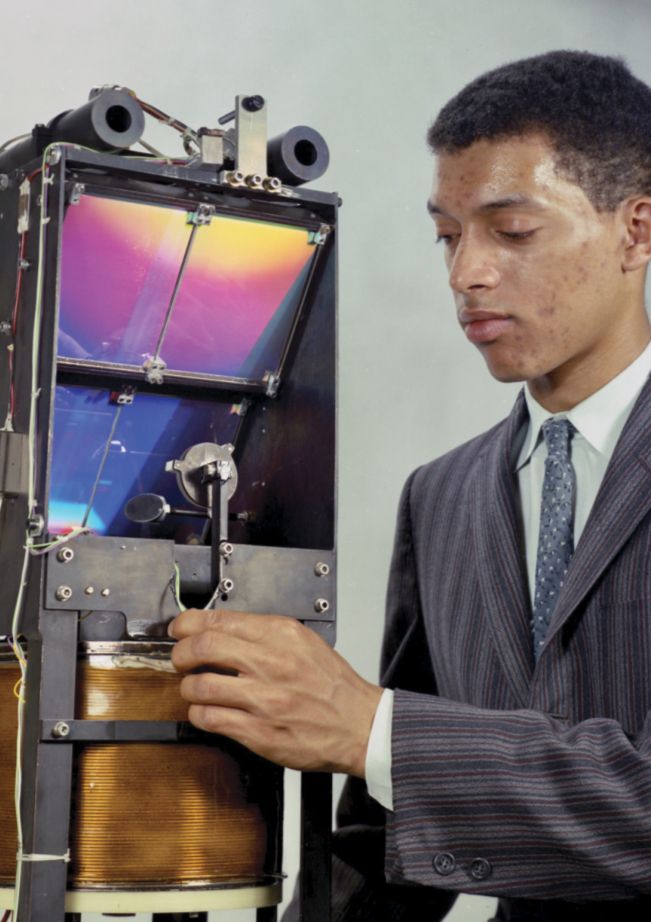George Robert Carruthers
DOI: 10.1063/PT.3.4756
George Robert Carruthers was an inventor, instrument designer, space scientist, and astrophysicist. He excelled in all, but he was fundamentally an innovator who could combine emerging hardware and techniques in clever ways to record phenomena in electromagnetic wavelengths accessible only above Earth’s atmosphere.

George Robert Carruthers
US NAVAL RESEARCH LABORATORY

George was born in Cincinnati, Ohio, on 1 October 1939 and lived on a small farm near Wright-Patterson Air Force Base (AFB), where his father was an engineer. His father died when George was 12, and the family moved to Chicago to be with his mother’s family.
George earned a BS in physics, MS in nuclear engineering, and PhD in aeronautical and astronautical engineering at the University of Illinois at Urbana-Champaign. While completing his dissertation on atomic nitrogen recombination in 1964, George was invited to give a colloquium at the US Naval Research Laboratory (NRL) in Washington, DC. He became the NRL’s first E. O. Hulburt Postdoctoral Fellow that December. He accepted a full-time staff position in 1967 and spent his entire professional career there. He was often seen riding his bicycle to and from work until his retirement in 2002. George died of heart failure on 26 December 2020 in Washington, DC.
I first caught sight of George at the dedication of the Lindheimer Astronomical Research Center at Northwestern University in May 1967. I was a first-year graduate student. Fred Whipple gave the keynote talk about his icy conglomerate (“dirty snowball”) explanation for comets. In a few years, George’s instruments would capture UV images of comets Kohoutek and Halley and discover the atomic-hydrogen haloes that emerge when those objects pass near the Sun. George’s shy demeanor was evident at the dedication.
When George began his NRL postdoc, several scientists there were using sounding rockets to explore Earth’s upper atmosphere and ionosphere in the UV and also the Sun in UV and x rays. George found his niche in the “rocket UV” involving nonsolar objects—stars, gaseous nebulae, nearby galaxies, comets, and Earth’s ionosphere and geocorona.
George exemplified the work ethic and values of the laboratory’s initiator, Thomas Edison. Some of the research environment pioneered by Edison still existed when George arrived at the NRL. He gloried in the freedom that allowed him to invent, design, and construct his instruments. Anything that he envisioned, and for which he could muster support, could be built on-site. There were facilities to machine and coat metal parts, fabricate delicate optical and electronic components, and assemble and test instruments in simulated space environments. Access to the Wallops and White Sands facilities provided launch opportunities on sounding rockets. As the space program grew, George’s longer-duration payloads were launched into Earth orbit from Cape Canaveral and Vandenberg AFB.
George flew his instruments on sounding rockets, satellites, manned space laboratories, and reusable space planes. Some of the payloads were autonomous or remotely controlled devices, whereas others required human hands to point, operate, and retrieve film canisters.
All of the cameras that George built can trace their origin to his patent in 1969 for an “image converter for detecting electromagnetic radiation especially in short wave lengths.” The UV cameras typically used highly efficient opaque alkali halide photocathodes deposited on the secondary element of a Schmidt optical system. Photons would pass through a UV-transmitting corrector element and reflect off the aluminized spherical primary mirror to form an image on the curved photocathode. Photoelectrons were accelerated electrostatically and focused magnetically to pass through a hole in the primary and impinge on silver halide emulsion film, microchannel plates, or CCDs.
Sometimes devices eliminated the corrector element or had the camera viewing a diffraction grating. That was the case with George’s first major discovery: On a rocket flight in March 1970, he detected molecular hydrogen in space—the most common molecule in the universe. The photograph shows George at age 30 with the instrument he used.
I first spoke with George in the Mission Control visitor gallery at NASA’s Manned Spacecraft Center in April 1972. I was in my second year of a postdoc. George, not quite five years older than I, was having a gold-plated camera operated on the lunar surface by Apollo 16 astronauts. My entrée was that I was using a Kron electronographic camera on the telescopes at McDonald Observatory. But George’s mind was understandably occupied by worries whether his camera would not be properly operated or function as planned. So our conversation was polite but brief. The camera received considerable notoriety as the “first astronomical observatory on the moon” and is most remembered by the dramatic image of Earth’s geocorona, tropical airglow belts, and polar aurora—the first time the whole Earth had been viewed in the far-UV.
My next contact with George occurred when I gave a colloquium at the NRL. I subsequently spent 15 years working in the office next to George and across the hallway from his laboratory.
In the early 1990s, George was determined to give back. He became quite involved with various educational outreach programs and mentored African American high school and college students at the NRL, Howard University, and around Washington, DC.
George received many honors and awards. The most significant was the National Medal of Technology and Innovation, presented by President Barack Obama in 2012. But I suspect the one George enjoyed most was being inducted into the National Inventors Hall of Fame—as was Edison.
More about the Authors
Harry Heckathorn. Church Creek, Maryland.
